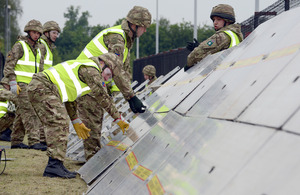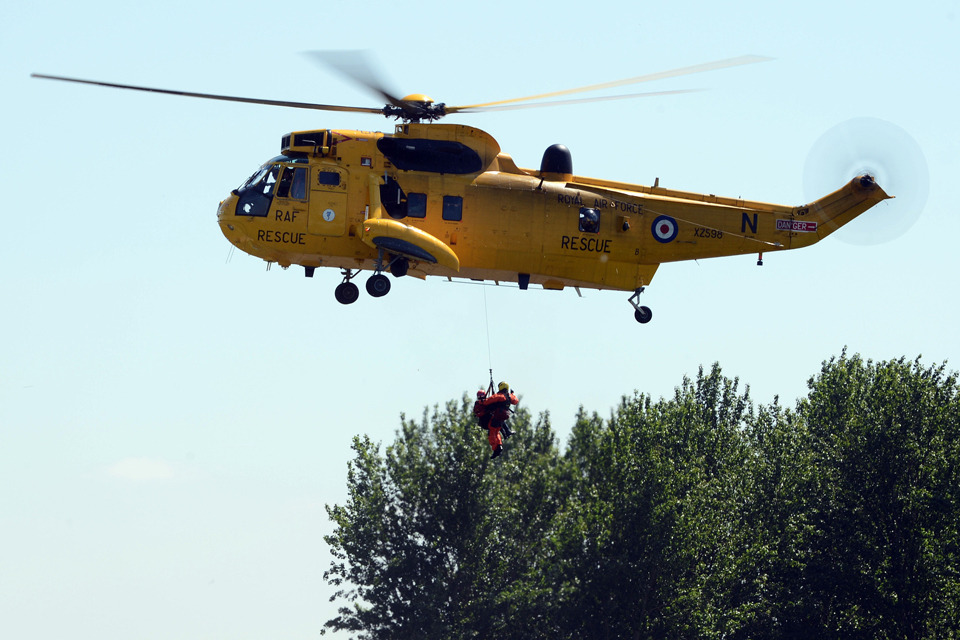Army takes part in emergency planning exercise
Army personnel have joined local authorities and emergency services to see how prepared they are to tackle a major environmental incident.

Personnel from 143 (West Midlands) Brigade erect a flood defence barrier at the National Grid gas compressor station at Alrewas during the exercise [Picture: Sergeant Russ Nolan RLC, Crown copyright]
Exercise Triton took place in Staffordshire and was designed to see how the Army worked alongside partners from the area when it comes to emergency planning.
220 personnel from 143 (West Midlands) Brigade, drawn from its headquarters, the Royal Mercian and Lancastrian Yeomanry, 159 Supply Regiment Royal Logistic Corps, Birmingham University Officer Training Corps and 22 Signal Regiment, were deployed on the exercise.
The scenario centred on abnormally heavy rainfall causing severe flooding around the county, including the failure of a dam at Blithfield Reservoir.
Tasks tackled by the military included erecting flood defence bunds (embankments) around the National Grid gas compressor station at Alrewas, assisting in the rescue of civilians and evacuating people at risk, and involved the use of a search and rescue Sea King helicopter.

Major incidents are logged as they occur [Picture: Sergeant Russ Nolan RLC, Crown copyright]
The brigade also provided senior staff for the strategic (gold) and tactical (silver) control groups based at Staffordshire Police headquarters and Tamworth Community Fire Station, respectively, as well as running an operations room from brigade headquarters at Copthorne Barracks in Shrewsbury.
The Army drew in soldiers and sailors from as far away as Plymouth and Aldershot to ensure a realistic mobilisation procedure.
The second exercise of its kind for Staffordshire and Stoke-on-Trent, it featured ‘players’ at all response levels, including live search and rescue play, with helicopters from the Royal Air Force, police and air ambulance operating from a combined co-ordination cell.
Lieutenant Colonel Guy Chambers, Joint Resilience Liaison Officer for the Army in the West Midlands, said:
Triton was the culmination of a series of exercises that we have been involved in with Staffordshire.
There is no doubt that the long history of integration with the Staffordshire responders and the military has fostered close relationships and detailed understanding. There is no question that the Staffordshire plans have been thoroughly tested and all parties have great confidence in the plans, the response and each other.

A Royal Air Force Sea King helicopter carries out a river rescue during the exercise [Picture: Sergeant Russ Nolan RLC, Crown copyright]
Project Manager Sarah Moore, from the Staffordshire Civil Contingencies Unit, said:
Exercises like this are really important to test our capabilities and find any flaws in our plans so that we are in a better position to respond should real events occur. All organisations taking part have put in a great deal of effort to ensure a realistic scenario and response.
Staffordshire Police Deputy Chief Constable Jane Sawyers added:
I would like to say a very big thank you to everyone who took part in Exercise Triton. The exercise provided a unique opportunity for all Staffordshire Resilience Forum (SRF) partners to practise their internal and multi-agency response plans in a realistic and challenging scenario.
Above all, we have had the confidence to commit to doing this through a 24-hour period of constant exercise play that simultaneously tested multi-agency gold, silver and bronze levels for the first time.
This was something that was endorsed by the SRF when the exercise concept was approved almost 2 years ago and it is perhaps the closest that we can come to simulating the pressure of a complex multi-agency response for real.
In order for us to build on the significant learning that will no doubt come from Exercise Triton, there will now be a range of follow-on activities aimed at capturing lessons from all participants.

Brigadier Gerhard Wheeler, Commander 143 (West Midlands) Brigade, receives a briefing from Lieutenant Colonel Christopher Ledsham [Picture: Sergeant Russ Nolan RLC, Crown copyright]
Participating players included Staffordshire County Council, Staffordshire Police, Staffordshire Fire and Rescue Service, West Midlands Ambulance Service, the NHS, utility companies, Highways and Transport, Staffordshire Civil Contingencies Unit, and various government departments and voluntary sector organisations. In all 37 different response agencies took part in the exercise.